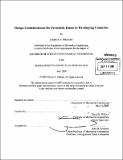| dc.contributor.advisor | David R. Wallace. | en_US |
| dc.contributor.author | Pikhart, Karina N. (Karina Nicole) | en_US |
| dc.contributor.other | Massachusetts Institute of Technology. Dept. of Mechanical Engineering. | en_US |
| dc.date.accessioned | 2010-04-28T16:56:35Z | |
| dc.date.available | 2010-04-28T16:56:35Z | |
| dc.date.copyright | 2009 | en_US |
| dc.date.issued | 2009 | en_US |
| dc.identifier.uri | http://hdl.handle.net/1721.1/54525 | |
| dc.description | Thesis (S.B.)--Massachusetts Institute of Technology, Dept. of Mechanical Engineering, 2009. | en_US |
| dc.description | Cataloged from PDF version of thesis. | en_US |
| dc.description | Includes bibliographical references (p. 24-25). | en_US |
| dc.description.abstract | Introduction: The design of prosthetic limbs is a complicated problem that continues to receive significant attention in research labs and in industry throughout the world. The idea of getting a machine to match human performance is an enticing one, and thus research continues to pursue the challenge of designing devices that can replace the functionality lost via limb amputation. Designers of prosthetics for developing countries face similar challenges. However, that challenge is also supplemented with a number of other contextual factors and considerations that must be made as a designer. As described by Cummings', these factors are social, economic, cultural, and geographic, and also include locally available forms of technology and time and distance constraints. These considerations further complicate the design process, especially for an engineer inexperienced with designing for the developing world and unfamiliar with the specific developing world environment being designed for. These topics have been covered in bits and pieces throughout the literature; this document attempts to cover them all thoroughly and in a logical way. This thesis also aims to provide some mechanism by which the challenge of designing a prosthetic knee for the developing world can be broken down and tackled effectively to yield an appropriate knee design. As amputees in the developing world are often subject to an inescapable life of poverty because they are unable to work and support their families, there is a strong impetus to design effective limbs for this population. This document intends to help facilitate that process. This thesis is inspired by a prosthetic knee design project that began in the class Developing World Prosthetics at the Massachusetts Institute of Technology in its inaugural term, spring 2008. Though the project was successful in many ways, the design process maybe could have been more effective with a stronger foundation in all the areas that will be covered below. This thesis primarily uses literature review to provide insight into human gait and amputee characteristics, as well as developing world considerations for designers of prosthetic limbs. The aim is to provide a foundation by which one can design effective and appropriate prosthetic devices. A metric is also developed by which those developing world considerations can be managed, weighed and incorporated into the design. In this case, experience and observations from the author's work on prosthetics in India are used to assess the contexts and contributions of various developing world factors to the successful incorporation of a prosthetic knee design into that environment. The document uses India as a case study; however, the thesis should serve as a generalized manual for developing world prosthetic knee design. This document begins with a presentation of human gait characteristics presented in a variety of contexts that can be useful to the designer of a prosthetic knee for the developing world. Then, basic mechanical components that are often used in prosthetic knee design are described, using examples. Finally, a thorough description of the many developing world factors that must be understood to design a sustainable prosthetic knee are discussed, and a table is presented by which those factors can be simply reviewed. | en_US |
| dc.description.statementofresponsibility | by Karina N. Pikhart. | en_US |
| dc.format.extent | 8, 2-25 p. | en_US |
| dc.language.iso | eng | en_US |
| dc.publisher | Massachusetts Institute of Technology | en_US |
| dc.rights | M.I.T. theses are protected by
copyright. They may be viewed from this source for any purpose, but
reproduction or distribution in any format is prohibited without written
permission. See provided URL for inquiries about permission. | en_US |
| dc.rights.uri | http://dspace.mit.edu/handle/1721.1/7582 | en_US |
| dc.subject | Mechanical Engineering. | en_US |
| dc.title | Design considerations for prosthetic knees in Developing countries | en_US |
| dc.type | Thesis | en_US |
| dc.description.degree | S.B. | en_US |
| dc.contributor.department | Massachusetts Institute of Technology. Department of Mechanical Engineering | |
| dc.identifier.oclc | 560673080 | en_US |
